Final report for LNE16-353
Project Information
At least 150 growers make cultural changes which reduce the severity of field-based diseases by 50% on 100 acres of garlic over three years. Assuming yield of 10,000 pounds per acre, and reduction from 10% to 5% infection, growers would realize an estimated 500 lb/A, or $4,500/A gross revenue/A.
Cooperators
Research
-
Cultural conditions in the field can be changed to affect disease infection rates on garlic.
-
Fusarium disease progression is affected by nitrogen fertility and inoculum source.
Methods to test hypothesis 1:
This hypothesis will be tested by implementing one year of field trials in two locations: Western New York and Eastern New York. Sites will be chosen in part for variation in soil type, and we also expect based on historical weather data to see different growing conditions in each site. The trials will be hosted on farms which have a history of struggling with field diseases. In each case the trial will be planted with seed which has tested positive for fusarium, and baseline infection rates of fusarium and botrytis prior to planting will be rated.
Treatme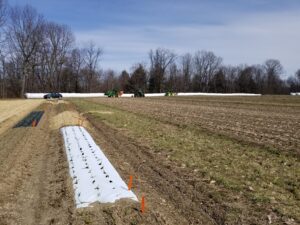 nts (all planted in German White unless noted, fall planted unless noted, and all with optimum fertility):
nts (all planted in German White unless noted, fall planted unless noted, and all with optimum fertility):
- Raised bed, white plastic
- Raised bed, black plastic
- Raised bed, straw mulch
- Raised bed, bare ground
- Raised bed, spring planted bare ground
- Raised bed, spring planted straw mulch
- Flat ground, white plastic
- Flat ground, black plastic
- Flat ground, straw mulch
- Flat ground, bare
- Flat ground, bare, spring planted
- Flat ground, straw mulch, spring planted
This trial will be set up in blocks by raised bed and flat ground, with randomization within these treatments. Each treatment will have four replications.
Data collection:
6 leaf stage: A stand count, plant uniformity, and disease/damage rating will be performed on each plot. Suspicious samples will be sent to Geneva for testing.
6-7 leaf state: Plant uniformity and disease/damage rating, with suspicious samples sent to Geneva.
Early bulbing: Plant uniformity and disease rating, with suspicious samples sent to Geneva.
Harvest/after drying: Final stand count, disease rating, and final yield/average bulb weight will be measured. A subsample of each treatment will be withheld for disease incubation.
Methods to test hypothesis 2:
This hypothesis will be tested by implementing field trials in two locations: Western NY and Long Island. Because the trials are being inoculated with fusarium, they will be hosted at research farms.
Treatments:
- Clean seed, optimum nitrogen
- Inoculated clean seed, optimum nitrogen
- Naturally infested seed, optimum nitrogen
- Clean seed in inoculated ground, optimum nitrogen
- Clean seed, low nitrogen – 50 lb/A
- Clean seed, High nitrogen – 150 lb/A
- Clean seed, optimum nitrogen, Oxidate dip + Terraclean drench every 14 days
- Inoculated clean seed, optimum nitrogen, Oxidate dip + Terraclean drench every 14 days
- Naturally infested seed, optimum nitrogen, Oxidate dip + Terraclean drench every 14 days
- Clean seed in artificially inoculated ground, opti nitrogen, Oxidate dip + Terraclean drench every 14 days
- Naturally infested seed in low nitrogen
- Naturally infested seed in optimum nitrogen
- Naturally infested seed in high nitrogen
Data collection: same as for hypothesis one, with the addition of foliar nitrogen sampling at 6-7 leaf stage in fertility treatments.
Farmer input: Growers have long grappled with the question of where fusarium comes from—is it in the seed or the soil? Is all fusarium the same? Growers (and vegetable specialist) also express concern about hydrogen dioxide dips not effectively controlling disease. Finally, growers have expressed concern that garlic, like many other crops, becomes “too soft” with excess fertility and becomes more susceptible to disease.
Field observational study:
Hypothesis: Garlic is suffering from different species or subspecies of Fusarium which vary in severity and primary inoculum source, and vary by garlic variety.
Broad sampling of industry in Northeast to determine variation in Fusaria:
August 2016: Examine samples collected throughout harvest 2016 season which exhibit fusarium symptoms (up to 90 samples from the Northeast)
July 2017: Repeat sampling at harvest in Northeast to determine if Fusarium species/type varies from year to year (additional 90 samples)
Intensive sampling for progression: 8 farms will be sampled in two varieties each: Porcelain and Rocambole (or other non-porcelain variety). Sampling will occur 4 times at distinct growth stages:
- Garlic at 6 inches
- At 6-7 leaf stage
- At early bulbing
- At harvest (if needed)
5 plants of each variety which appear unhealthy will be harvested and sent to Geneva for evaluation at each sampling.
Data from the 2017 growing season were analyzed and reported on in the following publications:
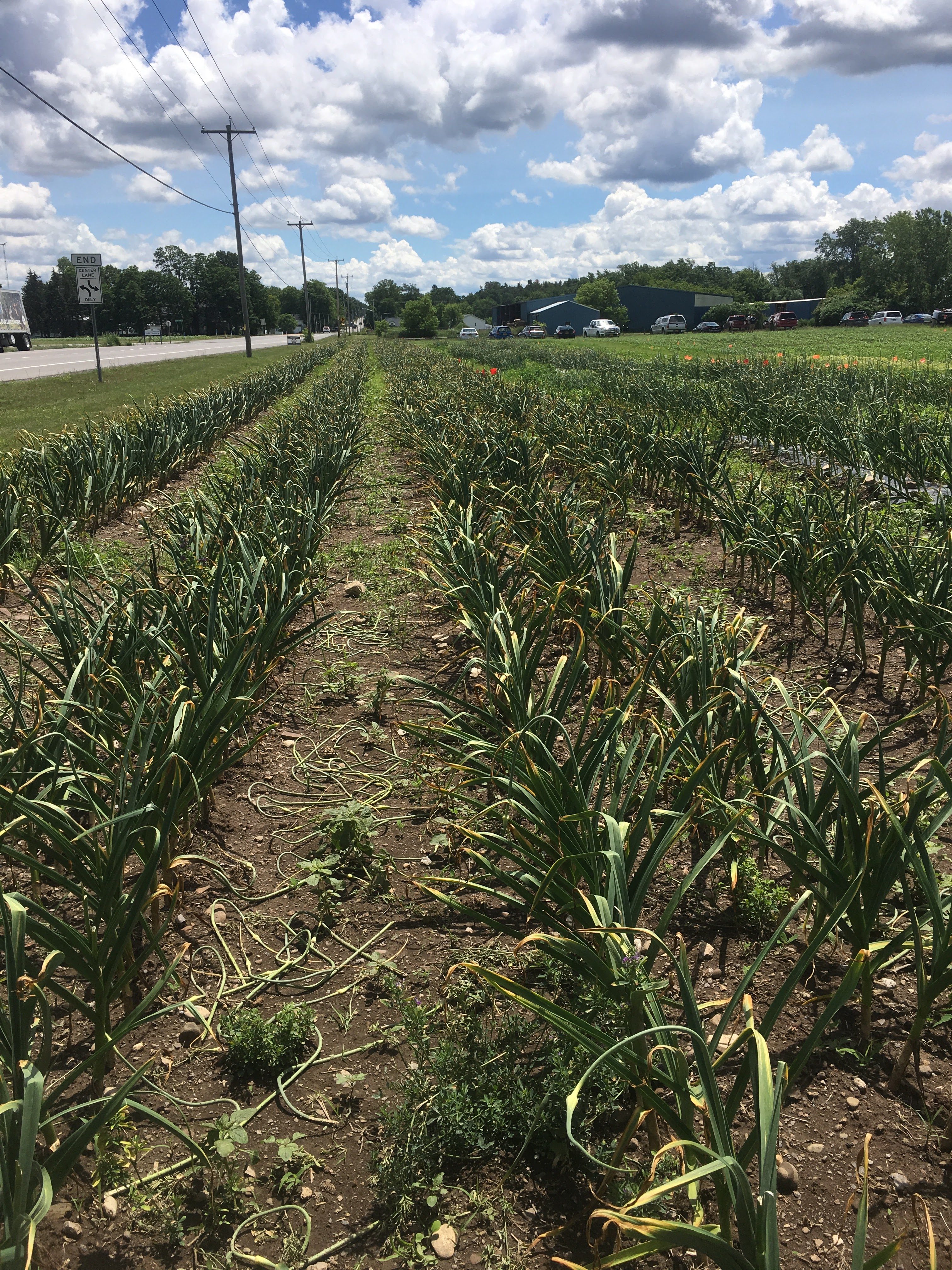
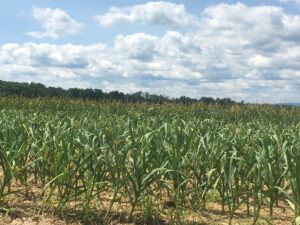
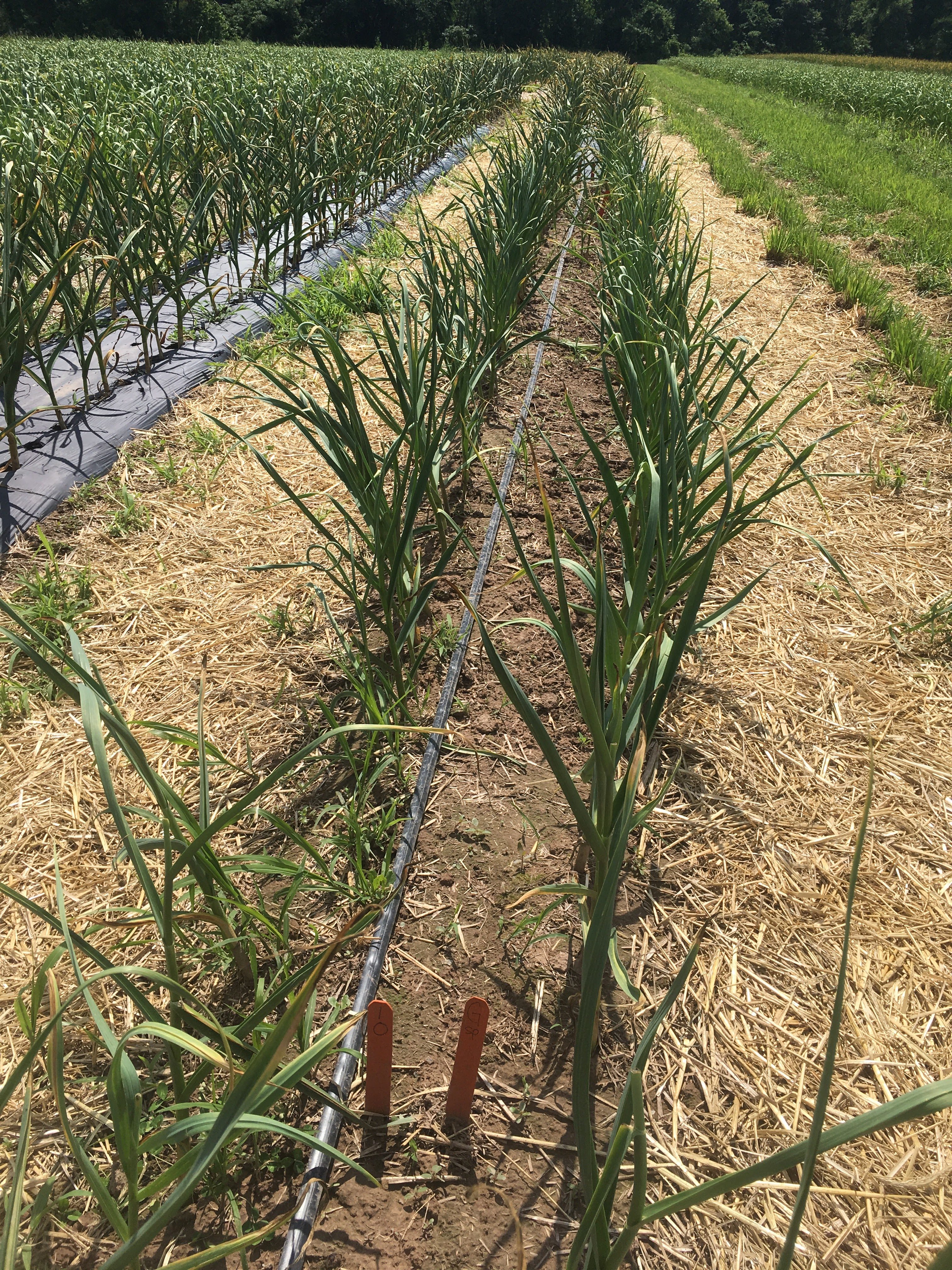
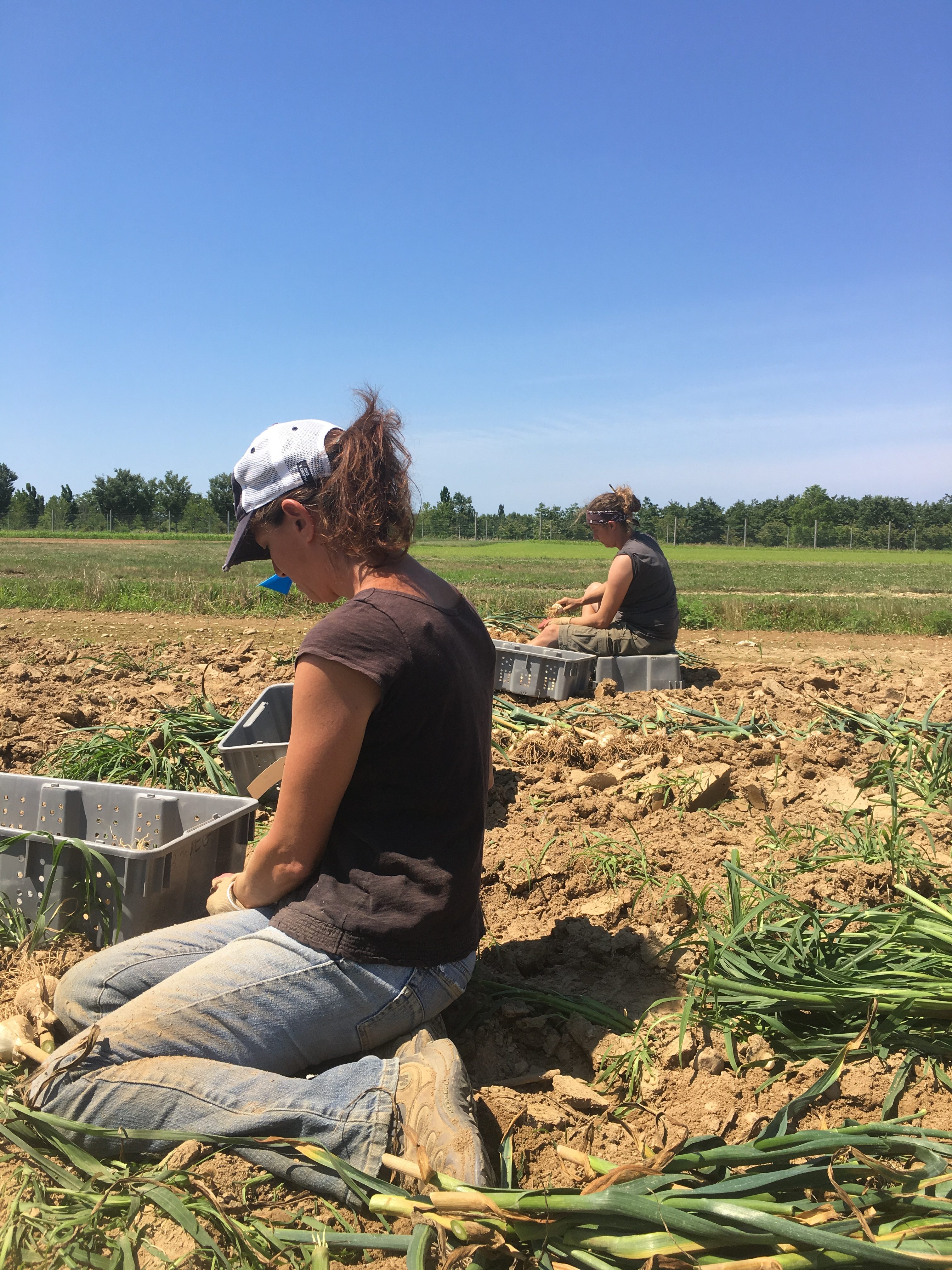
Roberts-Data-Garlic-Trial-2017
Copy-of-Fusarium-rating-data-sheet-Hadad-2018
Robert-garlic-2018-harvest-data
Fusarium-rating-data-sheet-2018
2018-Long-Island-Master-Garlic-Data

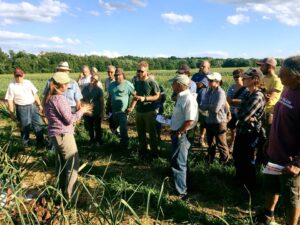
Education
Three grower meetings were held this summer to allow an opportunity to see how the garlic was growing under different conditions. A total of 83 growers attended the three meetings.


Milestones
At least 1000 growers receive information through CCE Eastern NY Commercial Horticulture Program’s Newsletter; CCE Cornell Vegetable Program’s Newsletter; CCE’s Long Island Fruit and Vegetable Report; and through the Garlic Press, in addition to other newsletters throughout the Northeast upon request, about field-based soil-borne disease management best practices and additional information about Fusarium including its apparent primary source (seed or soil), and any susceptibility differences in garlic varieties. This information allows growers to create crop rotations or make seed selections which reduce field-based disease levels (fall 2017).
1000
1350
December 31, 2019
Completed
December 31, 2020
Articles were published in all proposed venues, reaching approximately 1000 growers with written information. All Articles Combined Information was also shared through a podcast produced by ENYCHP, reaching approximately 80 listeners to date.
At least 100 growers attend field meetings demonstrating various cultural practices and their effects on field-based disease severity, with an emphasis on fusarium and other soil-borne diseases. Three field meetings will take place at research trial locations in the Mid-Hudson Valley of NY, at the Long-Island Research Farm, and in the Ithaca area. Growers leave understanding how to implement best practices on their farm, and know the costs and benefits of each practice (June-July 2017).
100
5
325
July 30, 2019
Completed
July 31, 2019
We held three field meetings at the trial sites this year. Batavia and Hurley meetings were well attended, but the attendance at the Long Island meeting was quite light due to the weather.
At least 300 growers learn about best cultural practices for field-based disease control at winter meetings throughout the Northeast, including NOFA NY (January 2018) and VT (February 2018); the NE Vegetable Conference (December 2017); New York’s garlic schools on Long Island in Eastern NY (February 2018), and in Western NY (February 2018); and the Mid-Atlantic Vegetable Conference (February 2018). Growers understand which cultural changes would result in the greatest reduction of field-based disease on their farms (winter 2017-2018).
300
325
December 31, 2019
Completed
December 31, 2019
Final results of the project were shared in a variety of venues, including to an audience of 150 growers at the New England Fruit and Vegetable conference allium fertility NEFV, to 30 growers at the NYS fruit and vegetable EXPO Garlic Nitrogen Expo, to 75 growers at the Maine Farmer to Farmer Conference Farmer to farmer 2019, and to 70 growers at NYS garlic schools Cultural controls trials.
Milestone Activities and Participation Summary
Educational activities:
Participation Summary:
Learning Outcomes
We did not do a good job of collecting changes in behavior during our last set of winter meetings. If requested, we will send out a survey now to attempt to rectify this. Otherwise, we plan to conduct surveys during the 2020 winter meetings (if held). Sincere apologies.
Edit: Due to the Pandemic, 2020 winter garlic schools were not held. These meetings will be held in fall/winter of 2021, and as requested, surveys will capture impact that this grant has had on grower practices managing Fusarium.
Performance Target Outcomes
Target #1
150
Growers will make cultural changes which reduce the severity of field-based diseases by 50% on 100 acres of garlic over three years.
100 acres
Assuming yield of 10,000 pounds per acre, and reduction from 10% to 5% infection, growers would realize an estimated 500 lb/A, or $4,500/A gross revenue/A.
50
Changes we have verified:
1) Switch to using black or white plastic or straw mulch
2) Switch to raised beds
3) Reduction of N fertilizer applied
4) Careful sorting of garlic seed
5) Use of oxidate as a surface sterilizer
25 acres
This has been challenging to quantify because growers don't know what their losses would have been if the changes had not been made. Anecdotally, and from farm visits, We are seeing lower rates of fusarium in fields that have implemented described best practices. The 5-10% decrease that we predicted seems to be accurate, based on grower reports. We may need to ask this question again in the next year or two to see how implementation has changed losses over a few seasons. I plan to ask this question during upcoming surveys.
Edit: this metric will be quantified during our 2021 garlic schools
Grower Survey 1 Grower Survey 2
Our survey results reflect that growers gained a clearer understanding of cultural controls that can reduce disease, with respondents reporting an average of 2.3/5 understanding of the issue prior to our meetings and an average of 3.9/5 understanding after our meetings. 88% of survey respondents also indicated that they were aware of changes they could make that would reduce disease severity on their farms.
Collecting information from growers at the larger meetings, including NOFA and NEFV, was confounded due to issues using our survey software. The surveys we did get good data from originated as paper copies. Our response rate from these was approximately 50%. We would like to deploy another survey in the coming year(s) to again track changes that growers have made as a result of the research in this project.
Based on my personal observations from farm visits with growers who have attended meetings, almost every farm who has attended a field day or meeting about this project has made changes, and many are seeing the quality of their garlic increasing. At least 10 farms (approx 10 acres)I have personally visited are experimenting with or switched to using plastic mulch from bare ground. Almost everyone is conducting more seed assessment before planting. On farm visits I am seeing better stands coming out of winter, longer storage life, and fewer field culls. We are also seeing a slow but steady decrease in nitrogen application, following the research results. One grower with 10 acres of garlic decreased their N application by 50 lbs/acre.
I would be happy to provide SARE with the survey results which come from our next round of meetings in order to strengthen our numbers. I am confident that if I survey growers again, we can verify the benchmarks set in the proposal. I'm certain we are there already, and just need the numbers to back up my observations.
Additional Project Outcomes
This grant was used to obtain a farm viability grant which allows us to do a second year of trialing. This second year of trialing increased the power of our results sufficiently to generate statistical significance.
A grower in Schoharie County, NY who had suffered upwards of 30% losses twice in the last 5 years decided to switch variety after learning that this is a main factor in managing Fusarium for some growers. They purchased 400 lbs of new seed from another local farm, and were able to increase their next year's yield from an average of 1500 lbs of garlic to 2000 lbs. This 500 lb increase represents a $5000 increase in revenue, and also a decrease in labor sorting through garlic to remove the diseased bulbs.
We benefited tremendously from the experience of our grower cooperators in developing our Fusarium management treatments. Grounding our possible treatments in the reality of farmer experience led to results which were more applicable to the farms we serve.